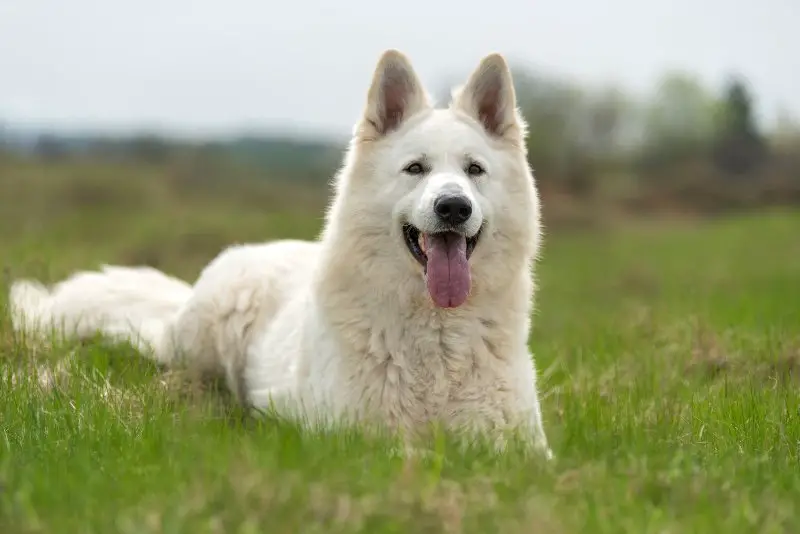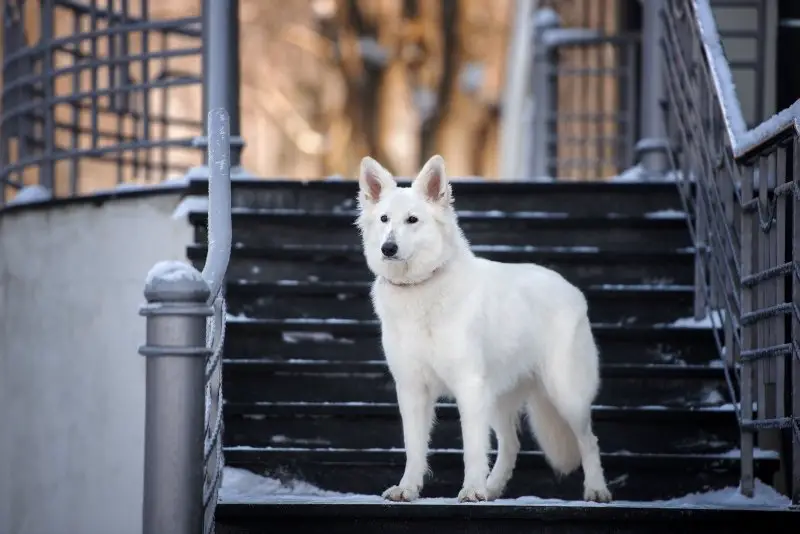
The white German shepherd dog (GSD) is a large herding dog of German origin. White German shepherds are also commonly referred to as white-haired German shepherds, white shepherds, and all-white GSDs.
White German shepherds are rare because of their white color, but are otherwise genetically identical to a standard German shepherd. All white GSDs weigh between 50 and 90 pounds and grow between 22 and 26 inches tall. These dogs, which live between 12 and 14 years, are loving, affectionate, and highly protective. White shepherds are obedient and love to please their owners.
The white shepherd needs an owner who is home often, or else the dog becomes anxious, leading to excessive barking and undesirable behaviors. Like standard German shepherds, the white dogs make great family pets and have excellent guard dog instincts because the dogs are suspicious of strangers and aggressive when needed. White German shepherds are hard-working service dogs due to their intelligent nature.
White German shepherds typically cost $750–$3,000 because of the dog’s rare status.
TABLE OF CONTENTS
White German Shepherd Characteristics & Overview
| Common names: | White-haired German shepherds, white shepherds, and all white GSDs |
| Origin: | Germany |
| Breed group: | Herding dog |
| Size: | Large |
| Height: | 22–26 inches |
| Weight: | 50–90 pounds |
| Colors: | White |
| Coat: | Stiff, short or long, double coat |
| Life expectancy: | 12–14 years |
| Temperament: | Loyal, protective, affectionate, and intelligent |
| Shedding: | Heavy shedders |
| Barking tendency: | High — when left alone and to alert owners |
| Cost: | $750–$3,000 |
Origin & Purpose
The standard German shepherd breed was discovered in the late 1800s by Captain Max von Stephanitz. The breed first worked in Germany as a herding dog and later worked in the army as a Red Cross aid.
The white German shepherd is recognized as a breed color of the standard GSD by the American Kennel Club (AKC) — except in the show ring — but is noted as a separate breed by the United Kennel Club. The white coat of these dogs primarily occurs from breeding two white German shepherds. Breeding a colored German shepherd that has the recessive white gene with a white GSD doesn’t guarantee the white – coated offspring.
Lifespan
The white German shepherd dog has an average lifespan of 12 to 14 years. The dog’s life may be shortened by common health issues the breed faces and lengthened by providing the dog with the proper diet and care needs.
All German shepherds are generally healthy, but are prone to cancer, skin issues, hip and elbow dysplasia, and other conditions. The white coat doesn’t represent albinism, and no health risks are linked to the coloring.
White German Shepherd Appearance

The white German shepherd looks identical to the standard GSD, except for the dog’s pure white coat. The body of a white shepherd has a proud posture, a solid muscular build, and a bushy tail. All white GSDs have an athletic build, a long body, deep chest, and erect ears — that usually bend over on white German shepherd puppies.
Height and Weight
White German shepherds are considered large dogs, with a height at the withers of 22 to 26 inches and a weight of 50 to 90 pounds. The female German shepherds are typically shorter and weigh less than males.
As a fast-growing breed, the white shepherd reaches half its full weight and height around four or five months and its full size at one year.
Coat
The white German shepherd has a fluffy white coat caused by a recessive white gene, which means this breed isn’t an albino dog. The recessive white gene doesn’t cause pale skin, a pink nose, or affect the dog’s eye color.
White-coated German shepherds typically have a double coat and rarely have a single coat. The dog’s coat is straight, thick, and dense, requiring weekly brushing for short- to medium-length coats and daily brushing for a dog that has a longer outer coat. The white shepherd sheds heavily, especially during shedding seasons, which are twice a year.
White German Shepherd Personality and Temperament
The white German shepherd is a hard-working and dedicated dog, like a standard German shepherd. According to the AKC, white German shepherds are aloof towards new people, alert, and stand their ground when protecting their families. This breed is not usually nervous, timid, or unnecessarily aggressive, and these characteristics signify improper training or socialization.
The white German shepherd’s loyal, energetic, and devoted nature is generally directed towards one owner in particular, making the dogs an excellent choice for individual active owners. The fearlessness and protective instincts of this breed — and gentleness towards children — make these dogs well-suited to families looking for a guard dog.
Barking
White German shepherds tend to bark frequently because of their herding instincts. This breed barks when left alone for long periods and to alert owners of strangers or other animals approaching. Train white German shepherds from an early age using obedience training and the “quiet” command to reduce the barking tendencies of the dogs.
White German Shepherd Care

The white German shepherd needs a high level of care, including exercise, mental, grooming, and food requirements. These high-maintenance dogs require daily brushing and vigorous exercise — provided by the owner with whom the dog has bonded. Owners must take the dog for regular veterinarian check-ups and look out for the common health conditions that affect white German shepherds.
Food Needs
Feed white German shepherd puppies roughly 1 cup of dry dog food, formulated for large, energetic breeds, split into three meals per day or according to a veterinarian’s guidelines. When the white GSD matures, at around one year, feed the dog approximately 3½ cups of high-quality dry dog food formulated for adult dogs. Consult a veterinarian to get a white shepherd’s specific dietary needs based on the dog’s size, activity level, and age.
Grooming Needs
Brush a white German shepherd that has a short to medium coat twice a week and a long-coated German shepherd daily — increase brushing during shedding season. Regular brushing prevents knotting, reduces shedding around the house, and keeps the coat shiny and healthy.
Avoid bathing white German shepherds unless the dogs are highly soiled because using soap often leads to skin irritations. Clean the white-coated dog’s ears weekly — especially after swimming. Brush the dog’s teeth at least twice a week. And cut the dog’s nails when they make a noise on the floor or prevent the dog from walking correctly.
Exercise Needs
Because of their herding and working dog instincts, white German shepherds need vigorous exercise to remain happy and healthy. Provide at least an hour, but preferably 90 minutes, of daily exercise for a white shepherd in the form of ball throwing games, runs, brisk walks, or swimming activities. The large-breed dog needs a large fenced-in yard to expel its energy and is unsuitable for apartments or small homes.
Mental Needs
To meet a white German shepherd’s mental needs, provide plenty of mental stimulation in the form of sniffing games, obedience training, teaching the dog new tricks, and agility sports. The intelligent nature of the breed results in digging holes, chewing on furniture, and other undesirable behaviors if the white dog isn’t given daily mental stimulation.
Common Health Concerns
White shepherds are typically healthy dogs, but like any dog breed, the white-coated dogs are prone to some health issues. Regular veterinarian checkups are necessary to prolong the life of the German shepherd dog.
Take note of the following health issues and seek veterinary advice if any of the symptoms arise:
- Degenerative myelopathy: results in a loss of control over the dog’s hind legs, visible by the dog dragging its limbs or having trouble standing up. Some cases are treated using vitamins, but most cases are untreatable
- Diabetes: causes loss of appetite, excessive thirst, and increased urination because of the body’s inability to regulate glucose properly. This condition is treatable through diet, exercise, and medication
- Dilated cardiomyopathy: created by a hereditary heart condition where the blood flows incorrectly throughout the dog’s body. To avoid serious illness and death in puppies, get the dog early treatment
- Elbow and hip dysplasia: causes difficulty walking and limb pain in these dogs and is a result of the improper formation of the dog’s hip and elbow joints. The condition is genetic and is treatable with medicine and physiotherapy
- Gastric dilatation-volvulus: also known as bloat, creates symptoms such as dry heaving, a hard, swollen belly, and excessive drooling. This life-threatening condition needs urgent medical attention and commonly affects large, deep-chested dogs. Prevent bloat by feeding the dog smaller meals and avoid exercise soon after meal times
- Hemangiosarcoma: causes lethargy, lack of appetite, labored breathing, and weakness in medium- to large-sized dogs. This condition is life-threatening when left untreated, but early treatment can prolong the dog’s life
- Idiopathic epilepsy: causes seizures and loss of control of the dog’s limbs, usually when the dog is between six months and six years old. This condition is treatable through dietary changes, medication, and exercise
White German Shepherd Training
The white German shepherd is easy to train because of the dog’s intelligence and eagerness to please its owner. Start training a white German shepherd puppy from as young as eight weeks to socialize and teach the puppy basic commands, including “sit,” “stay,” and potty training. Early socialization ensures a well-adjusted adult dog that isn’t unnecessarily aggressive, timid, or wary.
Give the dog daily stimulating training, beginning with short sessions that add up to 15 minutes each day. The white German shepherd responds best to positive reinforcement training using rewards and treats within the dog’s daily calorie allowance.
Avoid skipping training days as the white German shepherd unlearns behaviors quickly and responds better to consistent training. Group training is an excellent method to enable socialization and structured learning.
White German Shepherd Price
The white German shepherd puppy is an expensive breed because of its rare white coat. Buying a white GSD from a reputable breeder is more costly than getting the dog from a rescue center. Caring for this breed is expensive, especially during the first year of ownership.
How Much Is a White German Shepherd?
A white German shepherd generally costs $750 to $3,000 and is more expensive when the dog comes from a prized lineage. Adopting the white-coated dog costs between $300 and $700, and older dogs cost less than puppies. Adult white German shepherds have an established temperament, which is helpful for some owners but is problematic if the dog isn’t trained correctly.
How Much Does it Cost to Own a White German Shepherd?
In the first year of ownership, caring for a white German shepherd costs between $1,500 to $1,700 to get the necessary food, bedding, toys, and the initial vaccinations. Raising this breed costs less from the second year onward, at about $1,000 to $1,200 per year. The total lifetime cost of owning a white German shepherd is approximately $15,000.
Is a White German Shepherd Right for You?

White German shepherds are a magnificent breed and make excellent family pets for owners with young children, and great companions for single owners. However, despite the dog’s loyal, caring, and protective nature, the breed isn’t suitable for owners with ill-suited lifestyles.
White German Shepherds are Suitable for:
White German shepherds are ideal for families with young children because, with early socialization, the breed is gentle and protective around children. The alert and wary instincts of the white dogs make this breed an excellent guard dog that protects its family.
The white-coated German shepherd is an energetic dog, making it suitable for active families and owners who enjoy vigorous outdoor activities such as camping, hiking, and adventure sports. These dogs thrive in the great outdoors and are perfect companions for camping trips, adding an extra layer of security and companionship to outdoor adventures.
The white German shepherds, unlike standard German shepherds, aren’t typically used as working dogs, but their genetic build suits a working environment if necessary. The hard-working nature of this breed is suited to farm work, policing, search and rescue, and tracking.
White German Shepherds are NOT Suitable for:
The white German shepherd tends to become aggressive and unmanageable when improperly trained, making this breed unsuitable for owners that don’t have the means and time to give the dog training every day.
The white GSD is also unsuitable for inactive owners who can’t provide enough daily exercise and mental stimulation. Owners can leave this breed alone for short periods, but the dog displays destructive behavior when left alone for long periods.
The high prey drive and large size of the white GSD mean the dog needs a large fenced-in yard to stay healthy and constructively expel energy. The dog’s high energy levels and large size make this breed unsuitable for small homes and apartments.







Wonderful information about the White Shepherds. I have had German Shepherds since 1989, and would gladly give up a decade of my life if I could have just one more day with each of them. They are the best that life has to offer. May I always be worthy of them.
I had a large White GSD. He was a site to see and weighed 125lbs and was 27″at the shoulder. His name was Ghost and when I took him to the vet people thought he was a wolf.
Henry- that’s a big dog! I would love to find a breeder that produces males as large as Ghost. Would you be willing to share where you bought Ghost from? Thanks in advance for your time!